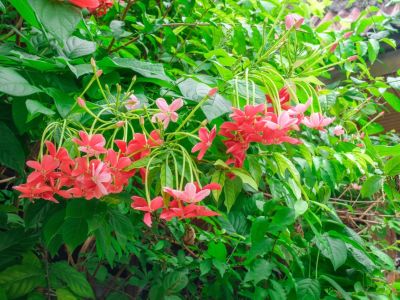The Latin name for rangoon creeper plant is Quisqualis indica. The genus name ‘Quisqualis’ means “what is this” and for good reason. Rangoon creeper plant has a form more closely resembling that of a shrub as a young plant, which gradually matures into a vine. This dichotomy flummoxed early taxonomists who eventually gave it this questionable nomenclature.
What is Rangoon Creeper?
Rangoon creeper vine is a woody climbing liana with green to yellow-green, lance-shaped leaves. The stems have fine yellow hairs with occasional spines forming on the branches. Rangoon creeper blooms white at onset and gradually darkens to pink, then finally red as it reaches maturity. Flowering in the spring through summer, the 4 to 5 inch (10-12.5 cm.) star-shaped aromatic blossoms are clustered together. The fragrance of the blooms is most striking at night. Rarely does the Quisqualis fruit; however, when fruiting does occur, it first appears as red in color gradually drying and maturing into a brown, five-winged drupe. This creeper, like all lianas, attaches itself to trees in the wild and creeps upwards through the canopy in search of the sun. In the home garden, Quiqualis can be used as an ornamental over arbors or gazebos, on trellises, in a tall border, over a pergola, espaliered, or trained as a specimen plant in a container. With some supportive structure, the plant will arch and form large masses of foliage.
Quisqualis Indica Care
Rangoon creeper is cold hardy only in the tropics and in USDA zones 10 and 11 and will defoliate with the lightest of frosts. In USDA zone 9, the plant will likely lose its foliage too; however, the roots are still viable and the plant will return as an herbaceous perennial. Quisqualis indica care requires full sun to partial shade. This creeper survives in a variety of soil conditions provided they are well-draining and is pH adaptable. Regular watering and full sun with afternoon shade will keep this liana thriving. Avoid fertilizers that are high in nitrogen; they will only encourage foliage growth and not flower set. In regions where the plant experiences dieback, flowering will be less spectacular than in tropical climes. The vine may occasionally be plagued by scale and caterpillars. The vine can be propagated from cuttings.
